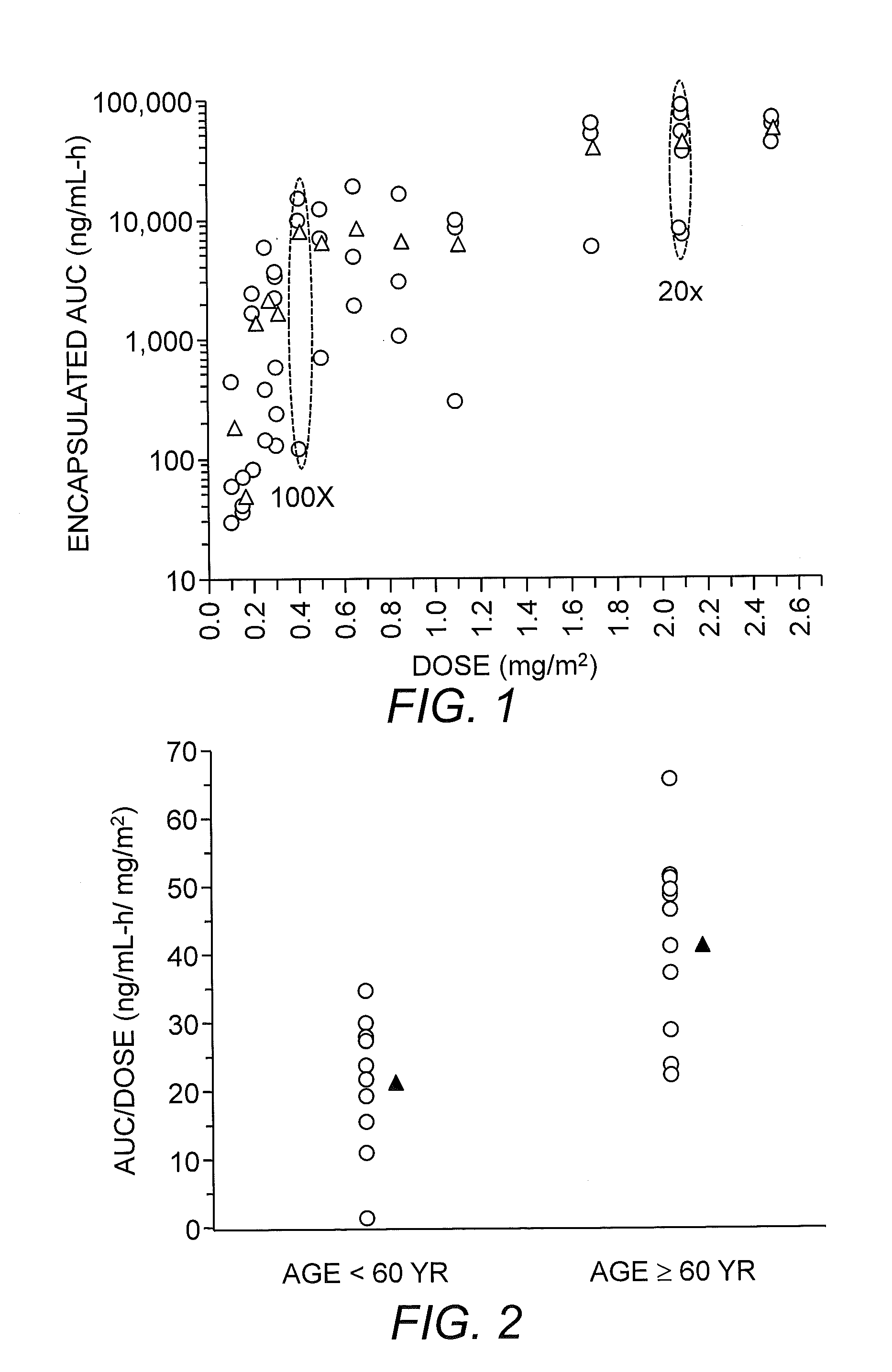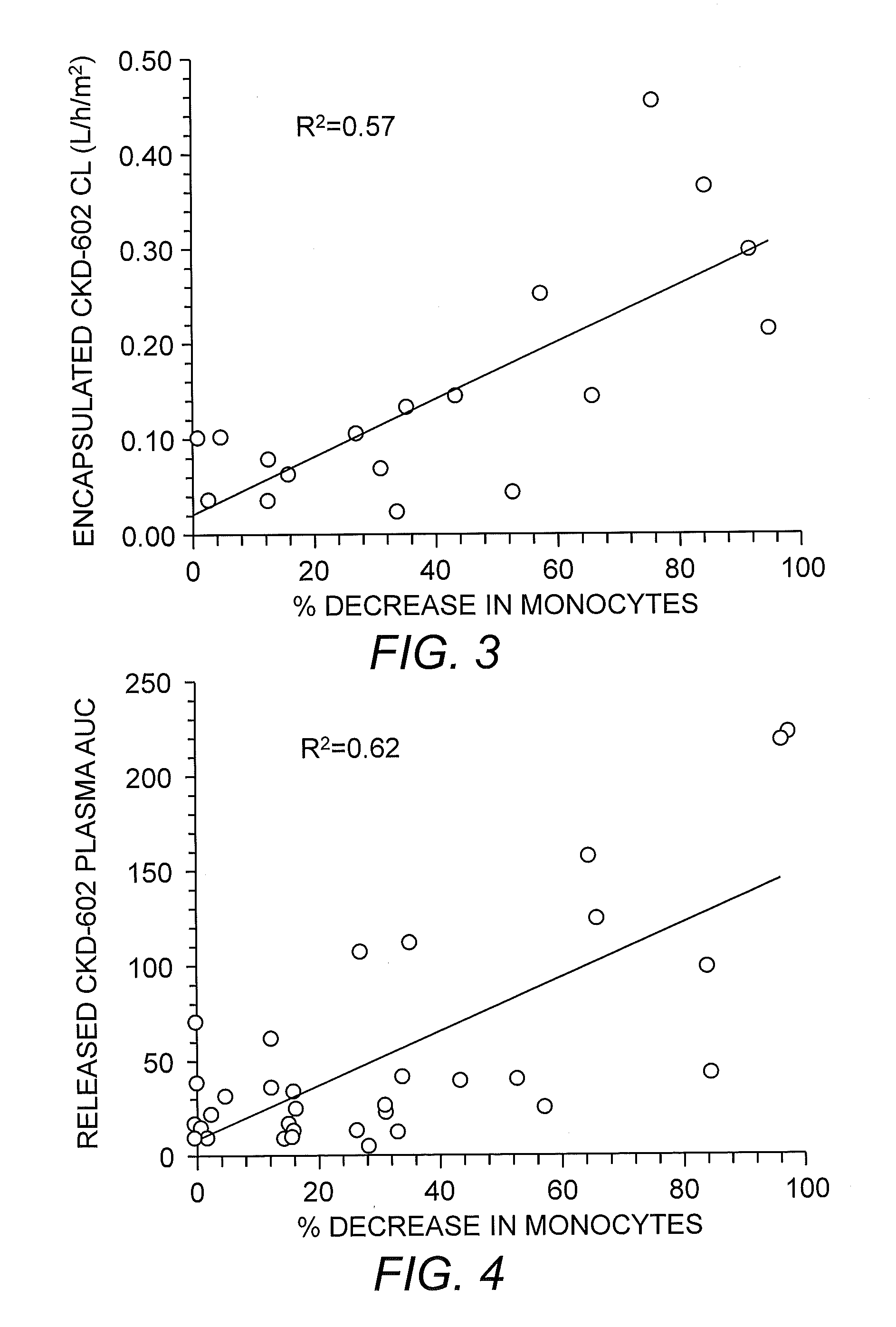Predictors of pharmacokinetic and pharmacodynamic disposition of carrier-mediated agents
a carrier-mediated agent and pharmacodynamic technology, applied in biocide, instruments, biochemistry apparatus and processes, etc., can solve the problems of reducing the response rate to pld, unable to address significant toxicity associated with hand-foot syndrome, and unable to achieve significant toxicity, etc., to achieve the effect of reducing the therapeutic index of anticancer agents, reducing the variability of liposomal anticancer agents administered intravenously (iv) and reducing the risk of s a carrier-mediated agent pharmacokinetic and pharmacokinetic and pharmacodynamic disposition and pharmacokinetic and pharmacodynamic disposition and carrier-mediated agent pharmacokinetic and pharmacodynamic disposition and carrier-mediated agent pharmacokinetic and pharmacodynamic disposition and a carrier-mediated agent pharmacodynamics of carrier-mediated agent pharmacokinetic and pk and pd and pd and pd, which is applied in the field of pd variability, high pd variability, pd variability
- Summary
- Abstract
- Description
- Claims
- Application Information
AI Technical Summary
Benefits of technology
Problems solved by technology
Method used
Image
Examples
example 1
PK and PD Variability of Liposomal Anticancer Agents
[0153]S-CKD602 is a pegylated liposomal formulation of CKD-602, a camptothecin analogue. In a phase I study of S-CKD602 IV every 21 days, we evaluated the PK of liposomal encapsulated and released CKD-602 in plasma. The interpatient variability in the exposure of encapsulated and released CKD-602 ranged from 20- to 100-fold (FIG. 1) and 10-fold, respectively. The interpatient variability in the PK of encapsulated CKD-602 was significantly greater than reported with non-nanoparticle agents administered IV or orally (Gabizon et al., (1994) Cancer Res. 54: 987-992; Amantea et al., (1997) Clin. Pharmacol. Ther. 61: 301-311; La-Beck et al., (2009) J. Clin. Oncol. 27(15S); Zamboni et al., (2009) Clin. Cancer Res. 15:1466-1472; Zamboni et al., (2009) Clin. Pharmacol. Ther. 86: 519-526). We also have reported that the PK variability of S-CKD602 is related to a patient's age, body composition and MO changes (Zamboni et al., (2009) Clin. Can...
example 2
PK and PD Relationship Between RES and Carrier-Mediated Chemotherapeutic Drugs
[0155]To examine the relationship between S-CKD602 PK and monocytes (MO) in patients, we evaluated the degree of neutropenia and monocytopenia as part of phase I studies of S-CKD602 and non-liposomal CKD-602 (NL-CKD602) in patients with refractory solid tumors. After administration of NL-CKD602, the % decrease at nadir in absolute neutrophil count (ANC) and MO were 86±11% and 87±12%, respectively (P>0.05). For NL-CKD602, the ratio of % decrease in MO to ANC was 1.1±0.4. After administration of S-CKD602, the % decrease at nadir in ANC and MO were 42±30% and 58±34%, respectively (P=0.001). For S-CKD602, the ratio of % decrease in MO to ANC was 2.1±2.0. The relationship between the % decrease in MO at nadir and CL of encapsulated CKD-602 and the release of CKD-602 from S-CKD602 in plasma are presented in FIGS. 3 and 4, respectively. There was no relationship between the pre-treatment MO count in blood and S-C...
example 3
Materials and Methods for PK and PD Studies
Determining Drug Clearance Rate
[0156]Blood samples (5 ml) were obtained one day prior to administration, at the end of in vivo infusion, and at 1 h, 3 h, 24 h, 48 h, 72 h, 96 h, and 168 h after administration of DOXIL®. Liposomal-encapsulated (inactive) and released (active) doxorubicin were separated in plasma via a solid phase separation method. Sum total (encapsulated and released), encapsulated, and released doxorubicin concentrations were evaluated in plasma. Sum total and encapsulated fractions were extracted from plasma using liquid-liquid extraction with protein precipitation. Released fractions were directly eluted from the solid phase separation matrix. Doxorubicin concentrations were measured using HPLC-fluorescence. The lower limit of quantitation for both plasma sum total and encapsulated doxorubicin assays was 10 ng / mL, the upper limit of quantitation was 30,000 ng / mL. The lower and upper limits of quantitation for the plasma ...
PUM
| Property | Measurement | Unit |
|---|---|---|
| Volume | aaaaa | aaaaa |
| Biological properties | aaaaa | aaaaa |
Abstract
Description
Claims
Application Information
 Login to view more
Login to view more - R&D Engineer
- R&D Manager
- IP Professional
- Industry Leading Data Capabilities
- Powerful AI technology
- Patent DNA Extraction
Browse by: Latest US Patents, China's latest patents, Technical Efficacy Thesaurus, Application Domain, Technology Topic.
© 2024 PatSnap. All rights reserved.Legal|Privacy policy|Modern Slavery Act Transparency Statement|Sitemap



